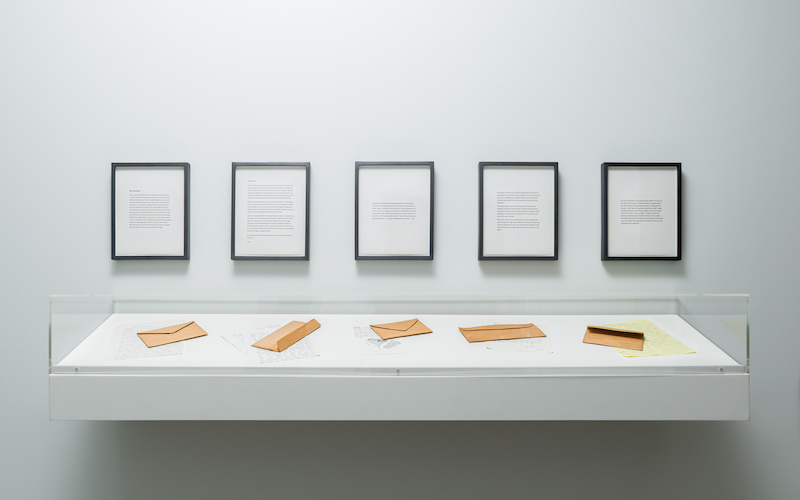 Humaira Abid. Letters from Home, 2019. Carved pinewood and letters from incarcerated youth. Seattle, WA. King County Public Art Collection/4Culture. Photo: www.joefreemanjunior.com
Humaira Abid. Letters from Home, 2019. Carved pinewood and letters from incarcerated youth. Seattle, WA. King County Public Art Collection/4Culture. Photo: www.joefreemanjunior.com
To steward diverse narratives for diverse audiences, 4Culture brought their public art collection online with Artwork Archive.
A public art program focused on modern initiatives needed a modern database.
4Culture, a cultural funding agency in King County, Washington, has taken a unique approach to serving its region. On top of grant programs in arts, heritage, and preservation, they are known for fostering genuine engagement and dialogue with their public art collection and ensuring access to cultural experiences for all. With initiatives to conserve and reframe the expansive collection, 4Culture turned to Artwork Archive as a solution—one that would allow them to manage their records online, continuing their mission in spite of the pandemic.
We interviewed Guy Merrill, 4Culture’s Public Art Collection Preparator, and Jordan Howland, 4Culture’s Curator and Collections Manager, to hear how they are using Artwork Archive’s cloud-based platform to continue—and broaden—their important work.
A small team with big collection needs
“For the collection, it's just Jordan and me,” shares Guy. “I'm the person in the field. Jordan is the curator and collections manager. We don't have a registrar so we're doing that work.”
“The nature of our collection is complicated enough. We have to do everything we can to make our processes easier and faster.”
King County is the 10th largest populated County in America. The King County Public Art Collection locations range in size and type–civic spaces like courthouses, jails, public health centers, airports, solid waste facilities, administrative offices, hospitals, etc. That’s a lot of places to keep track of...not including the artworks that are installed at these locations.
“It’s a challenge to get everywhere in such a large county,” shares Guy.
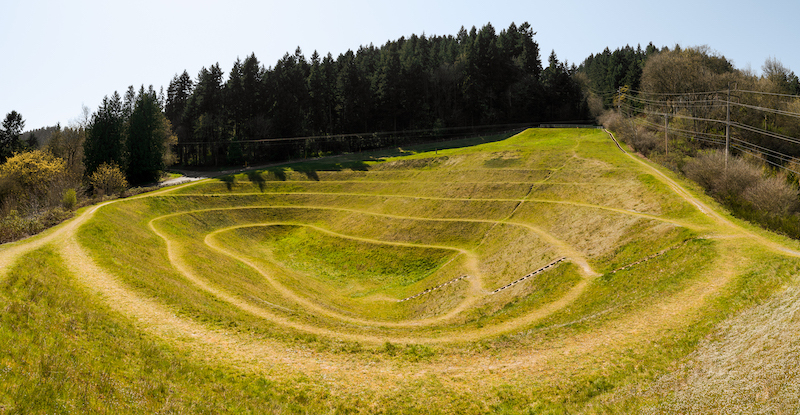 Robert Morris (1931-2018). Unt
Robert Morris (1931-2018). Unt
COVID was the push to finding a cloud-based collection management system
“We couldn't be in the field during the beginning of the pandemic. Judges would ask us to move artworks but we couldn’t,” says Guy. A need to bring art online was paramount.
When things got quiet, the research started. 4Culture, like many organizations, used the downtime to find a new database solution that would enable them to continue working remotely and safely.
Making the switch from PastPerfect to Artwork Archive
Prior to Artwork Archive, 4Culture was using PastPerfect (and before that, Access). Guy shares that there were a lot of limitations with PastPerfect. The agency needed something that was cloud-based.
As a program of an agency (a PDA to be exact) that is chartered by the county and functions much like a nonprofit, the collection did not have a lot of funding for a database so 4Culture had to find something affordable. Guy spoke with colleagues in the field and one of his contacts shared Artwork Archive.
“One of the biggest reasons why we moved to Artwork Archive was because it is a cloud-based system,” asserts Guy.
Guy explains how helpful it is to be able to pull up an object record while in the field–thereby assisting in the conservation and preservation of their artworks. “We have 2500 pieces spread out over 100 different places in the County. I can pull up the record within Artwork Archive, look at its condition history, see photos of it–what it’s supposed to look like versus what it looks like now. I can talk to Jordan immediately and discuss what we should do about the artwork.”
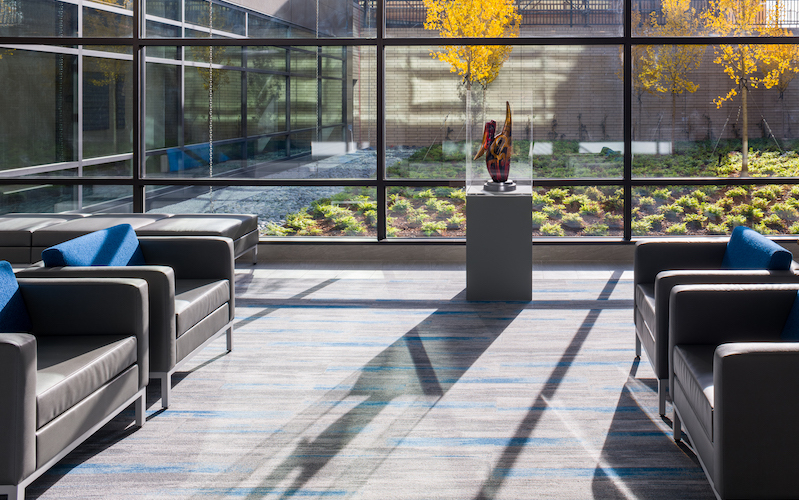 Preston Singletary. Hyacinth Medicine Amulet, 2016. Cast bronze. Seattle, WA. King County Public Art Collection/4Culture. Photo: www.joefreemanjunior.com
Preston Singletary. Hyacinth Medicine Amulet, 2016. Cast bronze. Seattle, WA. King County Public Art Collection/4Culture. Photo: www.joefreemanjunior.com
Why Artwork Archive was the solution.
Many of the features and benefits shared by Guy and Jordan relate to the maintenance and conversation of their robust public art collection. Artwork Archive helps them be better stewards of their artworks–ensuring that the objects, their stories and the legacies of the artists are preserved for future generations.
“Guy and I inherited a lot of deferred maintenance when we took over management of the collection. Our work has been very technical. Over the past year and half, it has been especially helpful to focus on the cleaning and restoration of site-specific and integrated artworks–to keep all of those already built projects in good repair and keep our regional technical specialists employed.” Keeping everyone afloat during this time (COVID) has been a priority.
-
Project management made simple
Like many public artworks located around the country, some of 4Culture’s works need cyclical maintenance. Guy is able to track maintenance in progress or upcoming treatments within Artwork Archive. He loves that he can easily digitize and share out condition notes and treatment plans.
Jordan is also excited to use Artwork Archive to track and manage new acquisitions. 4Culture has a small discretionary budget for annual artwork purchases and grows the collection when the county invests in new buildings and civic infrastructure, “We're lucky that every few years there’s a capital project that enables us to support both permanent project commissions and new portable purchases.”
-
Always have access to documents
“Being able to attach files to artwork records is a huge win for us,” states Guy.
Many Artwork Archive clients cite the importance of being able to attach documents to their artwork, contact, location and exhibition records. For 4Culture, it’s helpful that they can upload a quote on a restoration project from the vendor. This document is easily accessible on both the Contact and Maintenance records, allowing them to work more efficiently.
-
Easy report generation for streamlined collaboration
Guy shares that with Artwork Archive he can make and share reports effortlessly and even while on-the-go. “If Jordan texts me asking for information, I can generate an illustrated list of artworks for a particular building in a few minutes. Having that information at my fingertips is handy. Before, I was being umbilically corded to a server. Or, I was restricted by a slow VPN connection.”
Jordan shares another use case that was not possible with PastPerfect. “Artwork Archive helps us collaborate with County agencies. If they have a space that needs art, we can quickly look at what’s in storage and send a curated report of available works to them. It looks professional and is easy to generate. We don’t have to import images into a Word or Google doc anymore.”
-
Connect with your community
Another scenario that may be common among many civic art programs, which Jordan noted—is robust and accessible interpretation. Sharing information from Artwork Archive can help educate the public engaging with the work and invite them to be advocates.
Consider this example: 4Culture is conserving artwork in the hospital. To help explain the importance of the art and its site, Jordan created a Portfolio Page that showcased professional photographs of the piece, its story, and its connection with the space. This information was then shared with the staff in the building, alerting them to the project particulars and helping foster a closer connection to the art.
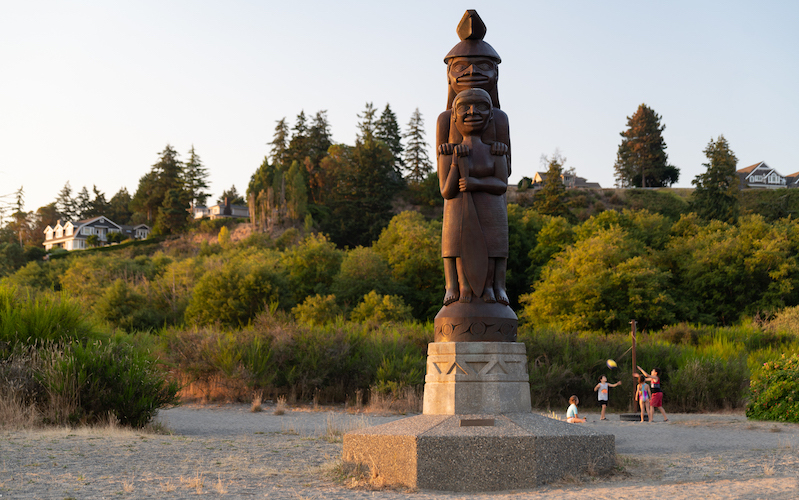 Andy Wilbur, Joe Gobin, and Steven C. Brown. Welcoming Figure, 1997. Cast bronze. Shoreline, WA. King County Public Art Collection/4Culture. Photo: www.joefreemanjunior.com
Andy Wilbur, Joe Gobin, and Steven C. Brown. Welcoming Figure, 1997. Cast bronze. Shoreline, WA. King County Public Art Collection/4Culture. Photo: www.joefreemanjunior.com
-
Artwork Archive has a visual layout for those that are visually minded
“The interface of Artwork Archive is so rewarding,” asserts Jordan. “It’s easy to navigate. It’s user-friendly. I have a hard time adopting new technology, and this has been pretty seamless.”
Guy explains how it’s helpful to find an artwork in their database by the image alone–”sometimes we are looking at something visually. I don’t remember the artist’s name or title. It’s helpful that I can open up a location and see the artworks’ image thumbnail. Finding artworks that way is so quick for us.”
-
Rediscover your collection. Fall in love with it (again).
The 4Culture team enjoys using the “Randomize Daily” sort function in their account. That means that every day their artworks will be shuffled and re-ordered.
Guy explains how the daily shuffle not only makes the database a pleasure to look through, but also supports his role as preparator:
“When I log in, with the randomized grid view, I’ll be surprised by artworks that I’ve never seen in person. And it makes me want to go and check them out. This keeps the curiosity of what’s in the collection alive. That’s great for maintenance and restoration. It’s important to remain curious–to go look and see the artwork in person. And, we may realize that an artwork needs work when we see it in person.”
-
Seamlessly store and access artist information
4Culture is in the process of filling out profile information for all of their collection artists. Artwork Archive allows users to create Contact records for the people that are a key part of their collections—including artists, donors, conservators, and more.
Jordan shares that, before Artwork Archive, gathering biographical information for all of their artists was cumbersome and time-consuming. They are excited to use the Artist Upload Form so that artists can upload not only their artworks and images, but their statements, CVs and more.
-
Play a part in diversifying the public art field
The 4Culture team is working with a state-wide consortium to create a “Fair Trades” resource list and training program. Their goal is to help identify and create mentorship, professional development, and real work opportunities for diverse technical specialists in the art field, especially ensuring that room is made for women and BIPOC individuals and companies. “We work with the same people over and over. The field is white male dominated.” The four partnering organizations -4Culture, City of Seattle Office of Arts & Culture, SoundTransit’s StArt Program, and ArtsWA- want to do what they can to change that.
While they are mapping out art handlers, installers, conservators, fabricators, framers, appraisers and more, 4Culture can track demographics and contact information for these art professionals in Artwork Archive’s fully-integrated CRM, or “contact relationship management” system. They can also create Contact Groups to track each type of art professional group.
How a database can support and promote diverse narratives
“We’re making a shift to be more inviting to more people. We’re doing a lot of work around racial equity,” Jordan says “We’re reframing what we ask of our artists and how we are reaching out to communities. We’re now receiving video statements of interest for new projects rather than just written submissions.”
These video statements and other unconventional provenance records can not only be uploaded and stored within Artwork Archive, but also shared publicly. Video and audio links can be included in the Public Profile–helping to amplify the stories of artists of all backgrounds.
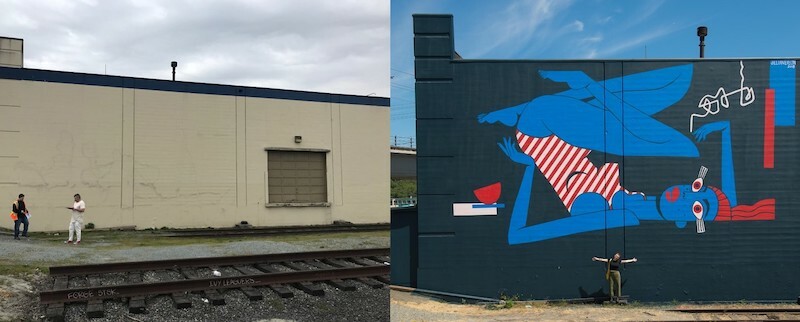 Jillian Evelyn. Balance (before/after), 2018. SODO Track, Seattle, WA. Photos: Wiseknave and Anna Kooris
Jillian Evelyn. Balance (before/after), 2018. SODO Track, Seattle, WA. Photos: Wiseknave and Anna Kooris
Using Artwork Archive to reimagine the collection and keep it alive.
4Culture also is embarking on a reframing project; they are focusing on the interpretation of artworks in particular locations.
This project focuses mostly in places where artworks do not rotate; meaning artworks that are considered part of site-specific sub-collections. To keep the works and their interpretation fresh, 4Culture is focusing on the stories of each artist and highlighting their unique cultural backgrounds. To this end, the 4Culture team is rewriting all of the artwork labels (and finding wall label generators to be a major time-saver in the process).
As Jordan explains, “the artwork cannot rotate out of the buildings in these cases, but its placement in the space and its interpretation can be revisited, allowing us to highlight new connections. We hope that the public will get a better sense of the artists behind the artworks and perhaps relate to their stories too. This kind of work helps keep the collection alive.”
Artwork Archive is a database that grows with your institution.
According to Guy, Artwork Archive’s website embed was one of the main reasons they selected Artwork Archive to manage their collection. Building out the public art section of their website has been an ongoing process. When they are ready, Artwork Archive will make synching their collection inventory directly to the site simple and intuitive, while also making it easy to share artworks, artist statements and project locations with the public. Expansion of their digital presence will benefit their local community and beyond.


-1_(dragged)_3_copy.jpg)




